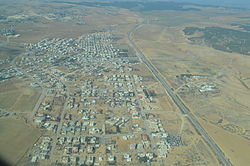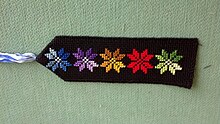Lakiya
Lakiya
Laqye | |
|---|---|
 | |
| Coordinates:31°19′28″N34°52′2″E/ 31.32444°N 34.86722°E | |
| Country | |
| District | Southern |
| Founded | 1982 |
| Government | |
| • Head of Municipality | Khaled el-Sana[1] |
| Area | |
| • Total | 5,728dunams(5.728 km2or 2.212 sq mi) |
| Population (2022)[2] | |
| • Total | 16,011 |
| • Density | 2,800/km2(7,200/sq mi) |
Lakiya(Hebrew:לָקִיָּה) orLaqye(Arabic:اللقية,romanized:al-Laqya) is aBedouintown (local council) in theSouthern DistrictofIsrael.In 2022 it had a population of 16,011.[2]
History
[edit]Lakiya was founded in 1985 as part of a government project to settle Bedouins in permanent settlements.[3]It is one of the seven original government-planned Bedouintownshipsin theNegevdesert.[3][4]
In 1999 the first local council elections were held, with Sheikh Ibrahim Abu Maharab elected as council head. Abu Maharab was later succeeded by Khaled al-Sana.
Since 2016, the Trans-Israel Highway 6 services Lakiya, being connected to the town through both the Lakiya andShoket Interchanges.
Demographics
[edit]According to theIsrael Central Bureau of Statistics(CBS), the population of Lakiya was 9,943 in December 2010[5](7,600 in December 2004). Its annual growth rate is 3.1%. Lakiya's jurisdiction is 5,728dunams(5.7 km²).
There are several Bedouin clans residing in Lakiya, the largest being al-Sana; other families are al-Assad, Abu Ammar and Abu Maharab. Some clans do not live inside Lakiya, but on adjacent territory.[citation needed]
Economy
[edit]In 2013, Arab-Bedouin women from Lakiya and other Bedouin towns participated in a sewing course for fashion design at the Amal College in Beer Sheva, including lessons on sewing and cutting, personal empowerment and business initiatives.[6]

The Lakiya Negev Weaving Project was founded in 1991 to empowerNegev Bedouin womenby applying their traditional weaving skills to the manufacture and sale of woven products.[7]It is based on the unique Bedouin heritage passed on from mother to daughter. Approximately 130 Bedouin women are involved in all the stages of the production from initial wool treatment, weaving the rugs, cushion covers and pouches, and sales.[8]The women were provided with professional guidance and hands-on assistance in marketing, branding, sales, the business's organizational structure and business plan, fundraising and networking. The aim was to create a profitable and financially independent cooperative business.[9]Several retailers and chains now sell the goods in Israel and abroad.[10]

The Desert Embroidery Project is another women's empowerment program in Lakiya[11]Some 20 women completed their professional entrepreneurial and business training and guidance and initiated a project based on the design and production of the traditional Bedouin costume jewelry. They are producing this embroidery at home with traditional Bedouin motifs and decorations. The women also hold Bedouin embroidery workshops and events based on the Bedouin tradition. Their workshop also serves as a visitors' center.[12]
Notable people
[edit]- Ismael Abu-Saad, professor of education,Ben-Gurion University of the Negev[13]
- Amal Elsana Alh'jooj,feminist and peace activist
- Roz Willey as-Sana, Bedouin Weaving project coordinator[14][15]
- Taleb el-Sana,an Israeli politician, the longest servingArab memberof theKnesset
See also
[edit]References
[edit]- ^PM Netanyahu meets with Negev Bedouin mayorsArchived2017-02-03 at theWayback MachineMFA, November 3, 2011
- ^ab"Regional Statistics".Israel Central Bureau of Statistics.Retrieved21 March2024.
- ^abHuman Rights Watch (Organization) (2008).Off the Map: Land and Housing Rights Violations in Israel's Unrecognized Bedouin Villages.Human Rights Watch. p. 16. GGKEY:X3Z6UW6BJ3C.
- ^State of Israel. Ministry of Justice, Ministry of Foreign Affairs. List of Issues to be taken up in Connection with the Consideration of Israel's Fourth and Fifth Periodic Reports of Israel (CEDAW/C/ISR/4 and CEDAW/C/ISR/5)Archived2013-10-15 at theWayback Machine
- ^"Statistical abstract of Israel 2011. POPULATION AND DENSITY PER SQ. KM. IN LOCALITIES NUMBERING 5,000 RESIDENTS AND MORE ON 31 XII 2010(1)"(PDF).Israel Central Bureau of Statistics. Archived fromthe original(PDF)on 2012-01-05.Retrieved2010-12-31.
- ^"Economic Empowerment. Arab-Bedouin Fashion Design".Nisped.org.il. Archived fromthe originalon 2013-10-15.Retrieved2013-11-19.
- ^Lakiya Negev Weaving
- ^Classic rug collection introduces Lakiya Rugs at Jewish marketplace
- ^"Bedouin projects. Lakiya Negev Weaving".Cjaed.org.il. Archived fromthe originalon 2013-10-14.Retrieved2013-11-19.
- ^"Israeli Bedouin Weavers from Lakiya at Santa Fe International Folk Art Market".Iataskforce.org.Retrieved2013-11-19.
- ^"Bedouin Tourist Sites".Itn.co.il.Retrieved2013-11-19.
- ^"Economic empowerment. Training Course in Jewelry Design and Production".Nisped.org.il. Archived fromthe originalon 2013-10-15.Retrieved2013-11-19.
- ^Talya Halkin. Empowering the disempoweredJerusalem Post, November 5, 2005
- ^"About us".Bedouinweaving.com.Retrieved2013-11-19.
- ^Desert WeavingsArchivedFebruary 25, 2009, at theWayback Machine
External links
[edit]- Lakiya Negev Weaving- website of one of Lakiya's main businesses
- Lands of the Negev,a short film presented by Israel Land Administration describing the challenges faced in providing land management and infrastructure to the Bedouins in Israel's southern Negev region



